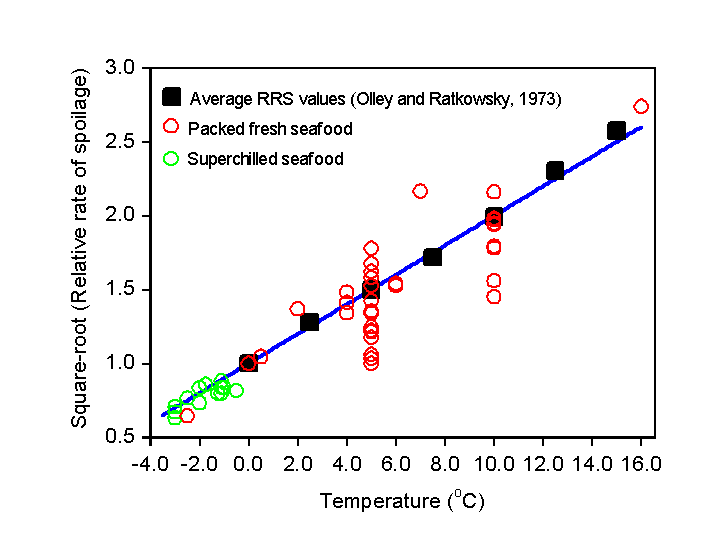|
|
| Model | Square-root model for relative rate of spoilage |
| Reference | Ratkowsky, D.A., Olley, J., McMeekin, T.A. and Ball, A. (1982) Relation between temperature and growth rate of bacterial cultures. Journal of Bacteriolgy 149, 1-5 |
| Factor(s) in model | Temperature |
| Range of applicability | Fresh seafood from temperate waters stored between -3°C and +15°C. The model is applicable for aerobically stored as well as vacuum packaged and modified atmosphere packed fresh seafood |
| Product validation studies: | |
| Aerobic storage of chilled fresh seafood | Numerous fish species (Spencer and Baines, 1964; Olley and Ratkowsky, 1973) |
| Superchilled fresh seafood | Cod, shrimp, mullet and seer fish (Dalgaard and Huss, 1997; Dalgaard, 1999) |
| Fresh, packed (Vacuum or MAP) and chilled seafood | Cod, crab, flathead, flounder, hake, salmon, sandeel, scallops, scampi, snabber, tarakihi, trout, ’white fish’, whiting (Dalgaard and Huss, 1997) |
| FSSP uses the simple square-root spoilage model (Eqn. 1) for the effect of temperature on relative rate of spoilage (RRS) of fresh fish from temperate/cold waters. This very simple model was initially developed based on growth characteristics for psychrotolerant microorganisms isolated from seafood. These psychrotolerant microorganisms had a theoretical minimum growth temperature (Tmin-value) of -10°C and this value is used in the square-root RRS model (Eqn. 1, Ratkowsky et al. 1982) |
|
|
| Although, very simple eqn. 1 appropriately fitted different
sets of RRS data for fresh seafood from temperate waters as shown in the Figure
just below. Shelf-life of fresh fish from temperate/cold waters is predicted at
different temperatures by using eqn. 2.
|
 |
|
Comparison of the square-root spoilage model (Eqn. 1 used with a reference temperature of 0°C) and different sets of relative rate of spoilage (RRS) data for fresh seafood from temperate waters. Modified from Dalgaard and Huss (1997) |
| The average RRS of fresh seafood is appropriately predicted by the square-root model (Eqn. 1). However, RRS data in a few studies showed considerable deviation (See Figure above). Details about the studies where deviations were observed has been reported by Sumner and Gorczyca (1981) and Cann et al. (1983). The most deviating results were obtained in experiments with the fish species flathead, hake, salmon, snapper and trout. However, other studies with the same fish species did not show similar deviations. Data from additional studies of the shelf-life of these fish species at different temperatures deserves to be evaluated. |